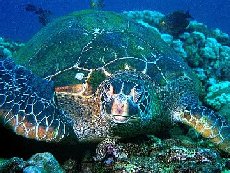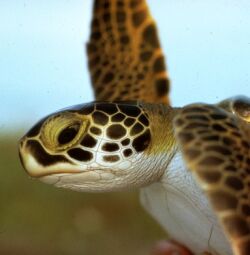Green Sea Turtle

Scientific Name: Chelonia mydas | Current Range: Mexico, FL
The Green Sea Turtle is the largest of the hard-shelled sea turtles. A typical mature green turtle has a carapace length of around 40 in (1 m) and weighs 300-350 lb. Its large heart-shaped shell varies in color from dark greenish brown to olive brown. The head is small, and the front legs are large and flipper-shaped.
Sea Turtles are mainly herbivorous, feeding on sea grass and algae, but hatchlings are partly carnivorous, and male turtles have been observed preying on an assortment of invertebrates. Hatchlings are eaten by birds on the beaches and by fish when they reach the water, but adults have few natural enemies in the wild.
Nesting occurs throughout the year at some sites, but is strongly seasonal at others. The female returns to the beach where she was born to lay her eggs. Mating takes place within a half mile of the nest beach; the male does not come ashore.
Because her limbs are more suited to swimming rather than to crawling, the female's progress on the sand is slow and difficult. She comes ashore at night and is extremely sensitive to disturbances caused by light, sounds, or vibrations. Using her rear flippers to dig a hole, she lays the eggs and buries them with sand, then returns to the water leaving the baby sea turtles on their own.

Why are these turtles threatened?
Sea turtles have always been exploited for food; the decline in their population has been obvious for hundreds of years. Local subsistence and local commercial exploitation appear to be having an increased impact on sea turtle populations, as tribal cultures decline, modern technology spreads, and human population in the tropics increases. The eggs layed by the female suffer human predation, and the ones that do hatch make their journey to the ocean, and on their way, they have to battle predation by land animals like birds and crocodiles.
Sea Turtle Conservation Links:
http://www.cccturtle.org/
http://www.oceanconservation.org/yucatan.html



